 |  | | THE TIDES OF TIME |
|  |  | | SCRIPT: Steve Parkhouse
ART: Dave Gibbons
EDITOR: Alan McKenzie ISSUES: 61-67
COVER DATES: February 1982 - August 1982
ON TV: Kinda - Time Flight (Season 19), The Curse of Peladon (repeat), Genesis of the Daleks (repeat), Earthshock (repeat), Kinda (repeat)
REPRINTS: Reprinted in Doctor Who (Marvel US) Issues 15 - 18, December 1985 - March 1986 (covers below), then in Doctor Who Classic Comics Issues 10 - 11, August - September 1993 in somewhat rudimentary colour (covers below), then as part of the Panini ‘graphic novel’ The Tides of Time (The Complete Fifth Doctor), published in May 2005 and then by IDW as part of their Doctor Who Classics Series 2, Issues 5 (April 2009) to 7 (June 2009), then in IDW’s Doctor Who Classics Omnibus Volume 2, released August 2011, and then yet again by IDW in the Dave Gibbons Collection, December 2011. When the Great Demon known as Melanicus is accidentally released from the Event Synthesizer, which ‘produces the ordered vibrations of the universe’, the Doctor and a knight named Sir Justin are soon caught up in the time anomalies this event causes. The Doctor pilots the TARDIS to Gallifrey where he hooks into the Matrix and contacts the Celestial Intervention Agency led by Rassilon. Also in the agency are other higher Evolutionaries including Merlin, who once banished Melanicus for one thousand years. Rassilon promises to help the Doctor locate Melanicus and restore the Event Sythesizer. |
| |
 |  | | Returning to the TARDIS, the Doctor and Justin are attacked by one of Melanicus’ event spells, but the assassin he sends to kill the Doctor is destroyed by Shayde (see below), and the TARDIS projected into the heart of Melanicus’ domain, a place of strange perception and dangerous dream-like unreality where the Doctor, Justin and Shayde are forced to fight for their lives. However, even as they manage to escape, the universe begins to suffer the effects of the demon’s interference as a Time War erupts on Earth and millennium fights millennium. The Doctor, Justin and Shayde are helped by Higher Evolutionaries from Althrace who direct the TARDIS to a white hole where they live. Here the Doctor learns that Melanicus was from the race of Kalichura in the Althrace system, and Earth was the first planet he set foot on upon his escape, helped to gain power there by a third century king named Catavolcus... until Merlin put an end to his reign. The Althrace built the Event Synthesizer and now use the power of their thoughts to reverse time and pinpoint its position, which allows the Doctor and Justin to pilot the TARDIS directly to it. A final battle ensues, with Shayde and Justin killing Melanicus. Unfortunately, Justin plunges to his doom whilst administering the killing blow. Time returns to normal and Shayde returns to Gallifrey. |
 | | | 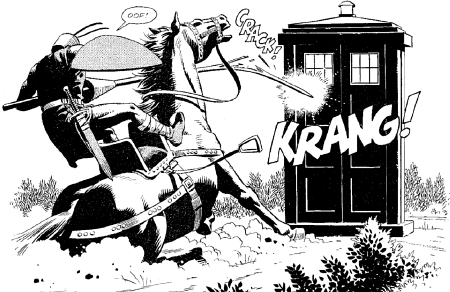 |
|  |  | | IMAGINARY FRIENDS - SHAYDE (Part One) A spectral figure and ‘secondary agent of the Time Lords’ created by the Celestial Intervention Agency and the Higher Evolutionaries and taking his thoughts from them. He is in constant contact with the Matrix and knows the workings of the TARDIS as well as (if not better than) the Doctor. He can move between dimensions and does not need to breathe air. Removing his head and plugging it into the bio-mechanical systems of the Althrace gives the Higher Evolutionaries direct communion with the Matrix Lords of Gallifrey. SHAYDE’S STORY CONTINUES HERE. |
|
| |
|
 |  |  |  |  |  |  | | | ALTERED VISTAS SAYS:
Despite a great deal of what could really be considered padding in its third, fourth and fifth instalments, The Tides of Time is one of the truly great Doctor Who comic strips, filled with humour, surrealism, mind-bending concepts and strong characters, not to mention fantastic artwork. Peter Davison’s difficult likeness has never been captured better than here in his first comic strip appearance, and many of the panels are truly stunning, especially the scenes of the Time War (surely part of Russell T. Davis’ inspiration for the new series’ backstory), Melanicus’ eruption from the Event Synthesizer, the evocation of an English village in summertime, and many sequences of panels set in Melanicus’ twisted domain. A breathtaking debut for the Fifth Doctor and an incredible new high for the comic strip. | | | | | IMAGINARY FRIENDS - SIR JUSTIN Sir Justin was a wandering, God-fearing and philosophical righter of wrongs from the Middle Ages. He was about to cross swords with Sir Hector of Richmond when a time anomaly scooped him up and deposited him close to Stockbridge in Gloucestershire in (presumably) 1982. Concussed and taken aboard the TARDIS by the Doctor, Justin quickly befriended the Time Lord. Apparently even on his narrow path he had encountered devilry, magic and demons. He sacrificed his life to destroy the demon Melanicus. Merlin built a statue of him in the Stockbridge village church to commemorate his bravery. We later learn in Endgame that the church has been named after Justin as Saint Justinians.
| | | | |  | | | | |
 |  | | Dave Gibbons said: ‘When I drew the first episode, I had the most tremendous difficulty getting the likeness of Peter Davison. He was like a blancmange - blond hair, light skin and no eyebrows! The trouble was that there was very little reference available - all there had been were publicity shots of him in tabloid newspapers and the Radio Times.’ “[Peter Davison’s] agent wanted to stop the first episode being printed because he felt it made his client look ugly! The upshot of that was that Peter Davison very obligingly let me and then DWM editor Alan McKenzie take reference photos on the set. After that the likenesses improved greatly, and in a true sense I actually ended up getting a better likeness of him than I had done of Tom Baker, which was more of a caricature.’ |
| |
 |  | | STARS FELL ON STOCKBRIDGE |
|  | | | 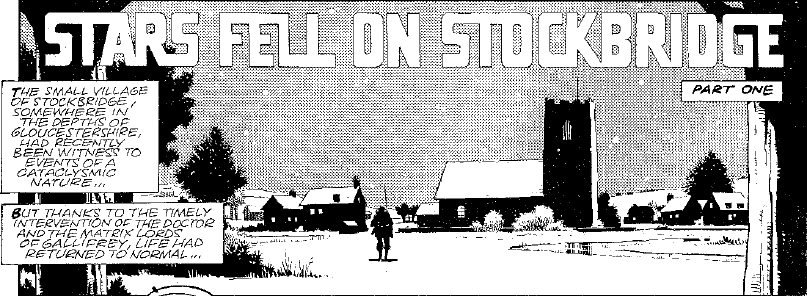 |
 |  | | SCRIPT: Steve Parkhouse
ART: Dave Gibbons
EDITOR: Alan McKenzie ISSUES: 68-69
COVER DATES: September 1982 - October 1982
REPRINTS: Reprinted first in Doctor Who (Marvel US) Issue 19, April 1986, (cover below), then in Doctor Who Classic Comics, Issue 18, March 1994 (cover below), then as part of the Panini ‘graphic novel’ The Tides of Time (The Complete Fifth Doctor), published in May 2005, and then by IDW in Doctor Who Classics Issue 7, June 2009, then in IDW’s Doctor Who Classics Omnibus Volume 2, released August 2011 (cover above), and then again from IDW in the Dave Gibbons Collection, December 2011. In Stockbridge (see here for an article about this fictional village), a much-ridiculed UFO spotter by the name of Maxwell Edison, using homemade equipment and hokum, detects an enormous spaceship heading towards Earth. Much to the Doctor’s astonishment, the ship actually exists and he and Edison travel there. However, they discover the ship is a ghost ship... with its own mysterious ghost. However, before they can solve the mystery completely, the ship begins to break up in Earth’s atmosphere. Edison is returned to Earth and able to tell the locals about the falling debris, the night stars fell on Stockbridge. |
| |
|
 | | |  |
 |  | | ON THE PLANET ISOPTERUS |
 |  | | SCRIPT: Unknown
ART: Glenn Rix
COVER DATES: 1983 (but annuals are always released towards the end of the proceeding year in time for the Christmas market)
REPRINTS: None After playing about with a ‘sort of dream machine’ aboard the TARDIS, the Doctor, Adric, Nyssa and Tegan land on Isopterus where giant radioactively mutated termites have overrun the planet and rounded up the humans there for food. The Doctor uses his handy ‘dream machine’ to tune into the termites’ wavelenth and convince them that there is a food source on the other side of the planet, thus leading the poor insects to certain starvation. Job done for another day, he promises Adric a turn on the dream machine... |
| |
 |  | | ALTERED VISTAS SAYS:
The occasional good likeness of Davison (clearly lifted from stock photos) cannot lift this lightweight and foolish tale above the filler that it is. Most of the time the regulars are unrecognisable, none of the companions has anything to do at all, a serious lack of action or tension and a far-too-convenient conclusion where the Doctor merrily leads the whole colony of termites to their certain doom using a device he just happens to have on him, even though none of the events can be blamed on the termites, and you have something that really isn’t very good at all. It is perhaps a blessing that this is the only Fifth Doctor annual to feature a comic strip. |
 |  | | THE STOCKBRIDGE HORROR |
|  |  |  |  |  |  |  |  |  |  |  |  |  |  |  |  |  | | SCRIPT: Steve Parkhouse
INKS: Paul Neary (1-2, 4-5)
ART: Steve Parkhouse (3), Mick Austin (6)
PENCIL ART: Steve Parkhouse (1-2), Mick Austin (4-5)
LETTERS: Steve Craddock (6)
EDITOR: Alan McKenzie ISSUES: 70-75
COVER DATES: November 1982 - April 1983
ON TV: K9 & Company (repeat), Arc of Infinity - The King’s Demons (Season 20)
REPRINTS: Reprinted first in Doctor Who (Marvel US) Issues 20-22, May 1986 - July 1986 (covers below), then in Doctor Who Classic Comics Issues 21 - 23, June 1994 - August 1994 (covers below), then as part of the Panini ‘graphic novel’ The Tides of Time (The Complete Fifth Doctor), published in May 2005, and then by IDW in Doctor Who Classics Issues 8 and 9, June-July 2009, then in IDW’s Doctor Who Classics Omnibus Volume 2, released August 2011. | | 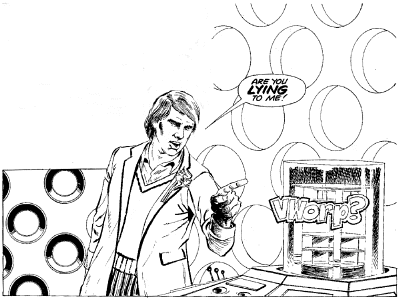 | | | | |  | | | An impression of the TARDIS is found embedded in the limestone of the Stockbridge quarry. The Doctor goes to see if his ship is still where he left it but finds it covered in a type of mud that will one day form the basis of sedimentary rock. While investigating the impression in the stone, the Doctor encounters a forest fire. At the center of the fire is an Elemental Being who seems to be controlling the fire. Surrounded in flames, the Doctor dives into the TARDIS and dematerializes. Unfortunately, the Elemental has attached itself to the outside of the TARDIS and manages to possess the ship’s main computer, removing it from The Doctor's control. When even the emergency shutdown fails to work the Doctor tries to make his way to the central computer core. Luckily, attempting to use the emergency shutdown alerts Gallifrey, and the Time Lords send Shayde to aid the Doctor. Shayde enters the master computer and is able to apprehend the Elemental Being. The Doctor then heads to Gallifrey in order to repair his TARDIS and heal the wounds he received during the events leading up to the forest fire. Once that has been accomplished, however, the Doctor finds himself on trial for allowing the Elemental loose on Earth. The TARDIS’s records state that the Elemental Being possessed the TARDIS whilst it was aboard the spaceship in Stars Fell on Stockbridge and, while the Doctor was enjoying the quiet life of rural England, it took the TARDIS millions of years back in time to witness the beginnings of life on Earth. Left stranded in the past, it sank into the mud and existed on Earth for all those years until the present day where it once again possessed the TARDIS. Shocked by all of this, and looking to clear himself, the Doctor notes that all the evidence against him comes from the TARDIS and that its memory banks have been incorrect before. The prosecutor of the trial states that the only other evidence is the impression of the TARDIS in the limestone back in the Stockbridge quarry. However, before it can be used in the trial, Shayde destroys the imprint. Left without credible evidence, the Doctor is set free but wondering why Shayde helped him and if he can ever truly be free. | | | | | | 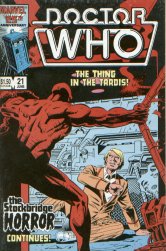 | | | | | 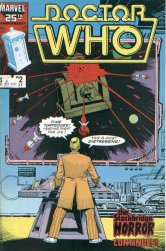 | | |  | | IMAGINARY FRIENDS - SHAYDE (Part Two) By the time of The Stockbridge Horror, Shayde has developed into more than a simple agent of the Matrix Lords. As it says in the strip, ‘the initiative was his to take because here he is activated by a signal sent from the emergency override switch aboard the TARDIS, fitted without the Doctor’s knowledge on his last visit to Gallifrey. Shayde enters the TARDIS computer, confronts the Elemental Being, joins with it and subdues it and manoeuvres it into the Matrix. He works against the express wishes of Rassilon and Gallifrey when he destroys the evidence in the quarry and saves the Doctor, yet the Doctor - whilst respecting him - remains unsure of his motives. SHAYDE’S STORY CONTINUES HERE. | | | | | | | |  | | | | |  | | | | | |  | | | | |  | | | | | ALTERED VISTAS SAYS:
This story, which starts so well in the now familiar surroundings of Stockbridge (surely a comic strip ancestor of the Third Doctor’s house in the country) becomes a little vague and meandering in its plotting, but is let down most badly by its artwork. Given the musical chairs that went on behind the scenes on the art duties, it is perhaps little wonder that the finished strip looks rushed and rough (the finest instalment being the third one, which was scripted and drawn solely by Parkhouse and recaptures some of Dave Gibbons’ fantastic style) but it badly damages the strip and takes it to an artistic low not seen since the days of TV Comic, the last instalment being particularly sketchy and uninspiring. Iconic images are few and far between, but the one above may have been in Russell T. Davis’ mind when Captain Jack clung to the outside of the TARDIS in Utopia.
| | | | |
|
 |  | | LUNAR LAGOON |
|  | | | 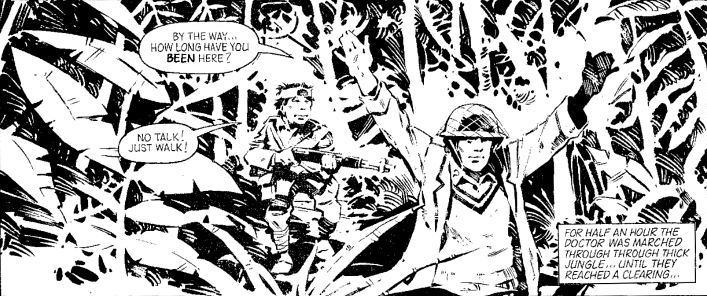 |
 |  | | SCRIPT: Steve Parkhouse
ART: Mick Austin
LETTERS: Steve Craddock
EDITOR: Alan McKenzie ISSUES: 76-77
COVER DATES: May 1983 - June 1983
REPRINTS: Reprinted first in Doctor Who (Marvel US), Issue 23, August 1986 (cover below), then as part of the Panini ‘graphic novel’ The Tides of Time (The Complete Fifth Doctor), published in May 2005, and then by IDW in Doctor Who Classics Issue 10, August 2009, then in trade paperback by IDW, May 2010, Volume 5, then in IDW’s Doctor Who Classics Omnibus Volume 2, released August 2011 (cover above). Recuperating from his trial on an island in the South Pacific in 1963, the Doctor is captured by a Japanese soldier named Fuji. However, the Doctor’s assertion that the war is over is challenged when the TARDIS is bombed by an American plane. Fuji is injured in the attack, but the Doctor nurses him back to consciousness. They begin to form a bond, but Fuji’s sense of honour and duty is stronger and he goes to hunt down a US airman who bailed out of his plane above the island. When the two soldiers meet, Fuji fires first. However, the Doctor was worried about Fuji’s instability and removed the bullets from his gun. The American soldier shoots him dead. |
 | | |  |
|  |  | | ALTERED VISTAS SAYS:
Despite explosions and dogfights, Lunar Lagoon is essentially a study of the uneasy relationship between the Doctor and a simple Japanese fisherman forced to defend his country. It is nice to be away from Stockbridge, the desert island makes a good setting for a story, and Steve Parkhouse’s policy of a short story that acts as a prelude and to a longer story still works to excellent effect, but I can’t help but miss the grandeur and excitement of The Tides of Time. There are still problems with the art, which looks untidy, but it is at least starting to appear like a style decision rather than because of a lack of time, though the US pilot manages to grow a slim pencil moustache between being in his plane and landing on the island, and the dogfight is presented very flatly and conveys none of the excitement that it should. Does anyone understand the significance of the title? There is no lagoon and the story is most definitely not set on the moon!
|
|
|
 |  | | 4-DIMENSIONAL VISTAS |
 | | |  |
|  |  | | SCRIPT: Steve Parkhouse
ART: Mick Austin
LETTERS: Steve Craddock (1), Jerry Paris (2-6)
EDITOR: Alan McKenzie ISSUES: 78-83
COVER DATES: July 1983 - December 1983
ON TV: The Visitation (repeat), Black Orchid (repeat), The Five Doctors
REPRINTS: Reprinted as part of the Panini ‘graphic novel’ The Tides of Time (The Complete Fifth Doctor), published in May 2005, and then by IDW in Doctor Who Classics Issues 10-12, August-October 2009, then in trade paperback by IDW, May 2010, Volume 5, then in IDW’s Doctor Who Classics Omnibus Volume 2, released August 2011 (cover above). Stunned by the tragic events in the previous story, the Doctor is about to enter the TARDIS when he encounters Gus, an American airman, who tells the Doctor that, although World War II is still going on, the current date is July 25th, 1963. Fearing he is lost in a parallel world, the Doctor and Gus take off in the TARDIS. While orbiting Earth, the Doctor learns that a magnetic anomaly emanating from close to the North Pole is responsible for the creation of the parallel worlds. The TARDIS lands near the anomaly and discover that its source is a space ship. Infiltrating the space ship, they discover the Meddling Monk and the Ice Warriors are working together on a scheme to build a giant sonic weapon. After the crash of several aeroplanes, an advanced military group known as SAG 3 is also investigating the anomaly. As the Ice Warriors prepare to drop the Doctor into a pit, SAG 3 attacks the Warriors’ ship, freeing the Doctor, and forcing the Warriors to launch their ship and leave Earth. Back in his TARDIS, the Doctor pursues the Monk's TARDIS through space and time. With some tricky manoeuvring, the Doctor is able to appear before the Monk who attempts to materialize in the same location. Having two TARDISs in the same position violates the laws of physics causing an explosion which destroys the Ice Warrior ship and sends the Monk to another dimension. Having solved the mystery of the parallel worlds, the Doctor and Gus depart in the TARDIS, but a clairvoyant member of the SAG 3 team is left to wonder if he should have told one of the travellers that he will soon die... |
 | | | 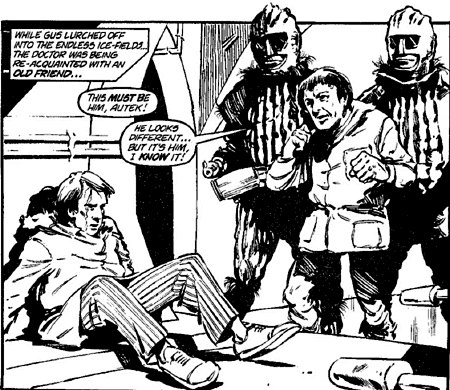 |
 |  | | IMAGINARY FRIENDS - ANGUS ‘GUS’ GOODMAN An American airman from Akron, Ohio, in a parallel 1963 where the Second World War was still being fought, Angus - or Gus - had been fighting the war for over a year, though he had been in the airforce for three years, having been drafted into the military. As a child he used to hitch rides on the backs of lorries. He had a smattering of technical knowledge. His reactions were ‘refreshingly direct’, according to the Doctor, and he wasn’t one for making considered decisions. After parachuting down onto a Pacific island and shooting a Japanese soldier named Fuji, he agreed to accompany the Doctor, partly to escape the desert island on which he was trapped, but partly, having admitted that he wasn’t exactly John Wayne, the whole war. The Doctor took him first to the Arctic where he encountered the Meddling Monk and the Ice Warriors. However, his fate was already predicted by a clairvoyant member of the military team who helped defeat the Ice Warriors. As the Doctor attempted to get him home, they next landed on Celeste in a conflict between the Corundum Mining Company and their slave workers, but their escape in the TARDIS attracted attention and the boss, a Mr Dogbolter, called in an assassin called the Moderator to seize the TARDIS for himself. When the Doctor finally got Gus back to 1963, the Moderator attacked, fatally wounding Gus who died by the TARDIS doors.
|
| |
|
| |
 |  | | THE MODERATOR |
 | | |  |
|  |  |  | | SCRIPT: Steve Parkhouse
ART: Steve Dillon
EDITOR: Alan McKenzie ISSUES: 84, 86-87
COVER DATES: January 1984, March 1984 - April 1984
ON TV: Warriors of the Deep - The Twin Dilemma (Season 21)
REPRINTS: Reprinted as part of the Panini ‘graphic novel’ The Tides of Time (The Complete Fifth Doctor), published in May 2005, and then by IDW in Doctor Who Classics Issue 13, November 2009, then in trade paperback by IDW, May 2010, Volume 5, then in IDW’s Doctor Who Classics Omnibus Volume 2, released August 2011. The Moderator cruises the galaxy with a million in platinum ingots from Intra-Venus Inc, instructed to track down the TARDIS. He casually wastes exotic life forms and temples while the same tune plays over and over in his head. Earlier, the Doctor and Gus land on a planet called Celeste where a group of high-tech soldiers called Gaunts pursue them for breaking curfew. They escape when the ground beneath them gives way, leaving them in a tunnel system below ground. Celeste is a mining planet owned by the mega-rich entrepreneur J.W. Dogbolter, half man, half frog, the most evil being in the universe. He is here to supervise the putting down of a revolt by the ruby miners, or Moles as they are known. His prime weapon is a combat robot called The Wrekka. Unfortunately this robot, armed with 300 weapons, is also brain damaged. However, it still tracks down the Doctor and Gus and arrests them as ring leaders of the revolt. When Gus’ life is threatened, the Doctor is forced to admit he arrived on Celeste in a time machine. Dogbolter is immediately interested, but the interrogation is interrupted by a Mole attack, allowing the Doctor and Gus to retreat to the TARDIS. This is when the Moderator is called in. Three weeks later he finally tracks the TARDIS to Earth just as the Doctor is dropping off Gus. He makes an attack, running across the sand and shooting Gus who manages to return fire. Three bullets hit the Moderator, whose armour is made to deflect high energy weapons, not lead bullets. As he falls, he realises that the song that has been plaguing him was ‘We'll Meet Again’, jammed on repeat on his headset. Gus dies and the Doctor picks up his gun and puts a bullet into the headset before leaving. The seriously injured Moderator is taken to hospital where he is given a private ward. There he is visited by Dogbolter’s aide, Hob, who switches off the life-support system as payment for the Moderator’s failure. | | | ALTERED VISTAS SAYS:
Steve Dillon’s crisp, accurate artwork with strong black areas makes a very pleasing contrast to what immediately proceeded it, often evoking the highs of The Tides of Time and Stars Fell on Stockbridge. The story itself is given weight by the portent of doom at the end of the previous strip and by the framing device of the Moderator closing in on his prey, but is essentially a lightweight and rather throwaway affair as the Doctor accidentally falls in with a miners’ revolt and meets an unusual robot. However, the story is given much greater depth by Gus’ untimely and unnecessary death just as the Doctor has got him almost home. That the Fifth Doctor only shoots the Moderator’s headset and not the Moderator shows just how helpless the character could be, swept along in events that he cannot control, and it is this aspect of the strip that is perhaps the finest tribute to the TV version of the character, where many events - from Adric’s death to his own premature demise on Androzani Minor - are beyond his control.
|
|
 | | |  |
 |  | | THE LUNAR STRANGERS |
 |  |  |  |  |  |  |  |  |  |  | |  | | | | SCRIPT: Gareth Roberts
ART: Martin Geraghty
LETTERS: Elitta Fell
EDITOR: Gary Russell ISSUES: 215-217
COVER DATES: August 1994 - September 1994 | | | | | 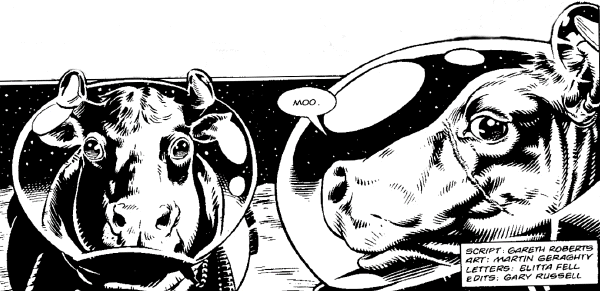 | | | | |  | | | | | | | The Doctor, Tegan and Turlough arrive at the Moon Village One Research and Study Base in the year 2015 shortly after two cows in space helmets have been found on the moon’s surface. The Doctor has discovered strange energy readings, but he is immediately roped in by the base’s leader, Miss Jackson, to investigate the cows. The cows are in fact of a race known as Dryrth and introduce themselves as Ravnok and Vartex. They claim their explorer craft was badly damaged forcing a landing, but it soon becomes apparent that they are a pair of evil cows intent on locating a treasure hidden beneath the base. Tegan and Turlough go to investigate the strange energy signals from beneath the base and soon discover it to be a Dryrth container while the Doctor lays a trap for the cows as they attempt to turn the base into a bomb. Unfortunately, his plan goes wrong and he is taken hostage by the Dryrth, who reveal themselves to be two of the galaxy’s most feared criminals. They hid the treasure on the moon and have now returned for it. The humans break in, killing Vartex but Ravnok escapes as the Doctor deactivates the critical reactor. However, Miss Jackson took the precaution of emptying Ravnok’s oxygen cylinder and she dies on the surface of the moon. The Doctor reveals to an aghast Miss Jackson that the container hidden beneath the base contains cheese. | | | | |  | | | | | | | 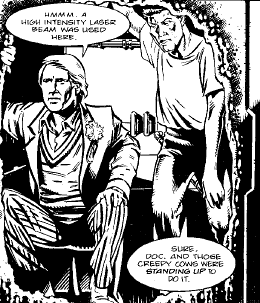 | | | | | ALTERED VISTAS SAYS:
This is Gareth Roberts’ first comic strip for Doctor Who Magazine, but it could hardly be considered his best work. Talking psychopathic cows hunting for cheese on the moon might have had him laughing his socks off, and had the editor quaking in his boots (editor Gary Russell apparently suffers a morbid fear of the creatures) but it translates badly to a three part story where the tone is generally quite serious. The art is a mixture of the extremely good (particularly the space cows) and the extremely bad (Tegan is virtually unrecognisable in every panel). One is left to wonder what sort of cheese leaves the ‘extraordinary’ energy readings that the Doctor has been chasing... It is worth noting that, in Doctor Who Monthly/Doctor Who Magazine, this is the first time that the Fifth Doctor has been seen with any of his TV companions and also the first time he has been seen travelling with a woman!
| | | | |
 | | |  |
 |  | | BLOOD INVOCATION |
|  |  | | SCRIPT: Paul Cornell
ART: John Ridgway
COLOUR: Paul Vyse
LETTERS: Jane Smale
EDITOR: Gary Russell The Doctor receives a distress signal from the Time Lords and returns to Gallifrey. Tegan is unwell so he leaves her in the TARDIS and goes to investigate with Nyssa. Cardinal Hemal shows them a body drained of blood with puncture marks at the throat and the Doctor knows immediately that they are dealing with vampires. A short jog and they discover a cult of Time Lords worshipping vampires, but one of their members has been infected with vampire DNA and he cannot be found. They return to the TARDIS where Tegan seems much better, but the reason is that she has been converted into a vampire by the cult’s leader who is aboard. He dematerialises the TARDIS planning to infect the whole universe with vampirism, starting with Earth, but the TARDIS lands during the day rather than at night and the vampire turns to dust as the doors open. Tegan is immediately free of the vampire curse. |
|
|  |  | | ALTERED VISTAS SAYS:
Perhaps a little too brief for any atmosphere or tension to really develop, but the story, which is a sequel to State of Decay, Blood Harvest and Paul Cornell’s own Goth Opera, is neatly told in fairly attractive artwork, even if the panels are largely a little dull in their layout. The full page opening panel has a wonderful sense of drama. The colouring is uninspiring but generally sympathetic to the strip, even if the Doctor appears to be wearing his successor’s trousers!
|
|
| |
 | | |  |
 |  | | THE CURSE OF THE SCARAB |
|  |  | | SCRIPT: Alan Barnes
ART: Martin Geraghty
LETTERS: Elitta Fell
EDITOR: Gary Gillatt ISSUES: 228-230
COVER DATES: August 1995 - September 1995 The Doctor and Peri are in Hollywood, 1938, where Seth Rakoff is making a film called The Curse of the Scarab. However, the Doctor notes that one of his props is actually the scarabaeus, a four-thousand-year-old sarcophagus of a forbidden cult. Shortly after, the producer is cut down and eviscerated by an Osirian servo-robot. The Doctor leads Peri to a prop pyramid, actually an Osirian ship which contains two of the mummy-style robots, the producers internal organs and the star of the show who reveals that Seth plans to resurrect Kephri the beetle-god from the scarabaeus, but Seth shoots him before he can reveal any more: the ceremony is about to begin. With Peri and the Doctor held by robots and the cast and crew of the film held in a trance, Seth begins the ceremony, but the scarabaeus is empty. Kephri already possesses the lead actor’s body, and, once free of a sacred symbol hung about his neck, transforms into a giant insect that summons flies from all across the world. The flies consume Seth, but the Doctor turns on a stage light and casts the shadow of the symbol onto Kephri, which freezes him. The Doctor then orders one of the service robots to impale Kephri with a spear which ends his power, though the book of invocation survives and passes into other hands... |
| |
 | | |  |
 | | | 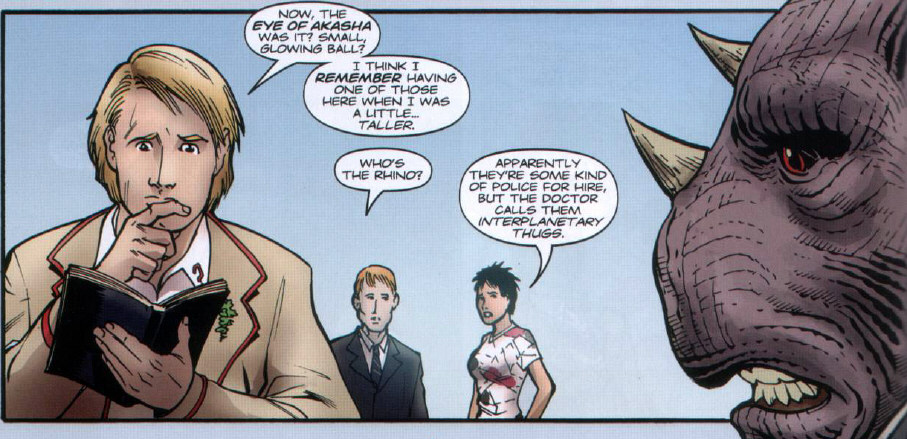 |
|  |  | | SCRIPT: Tony Lee
ART: Stefano Martino
LETTERS: Richard Starkings
EDITOR: Denton J. Tipton ISSUE: 3
COVER DATES: October 2008
REPRINTS: Doctor Who: The Forgotten, ‘graphic novel’, IDW April 2009. This story is a mini-story told within a much larger tale. To see the larger tale, click here. The Judoon come to Earth in search of the Eye of Akasha, which just happens to be in a house that the Doctor owned whilst working for UNIT. When the Judoon threaten Tegan’s life, the Doctor is forced to give them what they want... but he tricks them and instead gives them a cricket ball. |
|  |  | | ALTERED VISTAS SAYS:
How much you appreciate this short tale within a tale will probably depend in part on how much you like seeing a new series monster pitted against a classic series Doctor. All three of the regulars get something to do (even if it is just fetching the Doctor’s diary in poor old Turlough’s case), but the atmosphere is perhaps rather too jokey to accurately evoke the generally rather serious era of the Fifth Doctor, and, whilst the art is pleasing due largely to the colour, the likenesses of the regulars isn’t exactly what you would call spot on, with Tegan and Turlough in particular only being recognisable from their outfits, though they are characterised quite nicely. |
|
| |
|